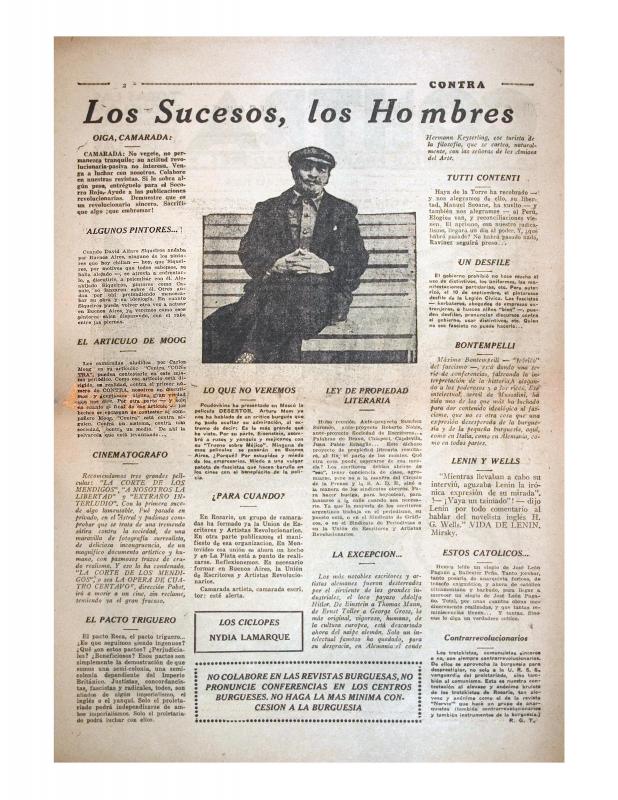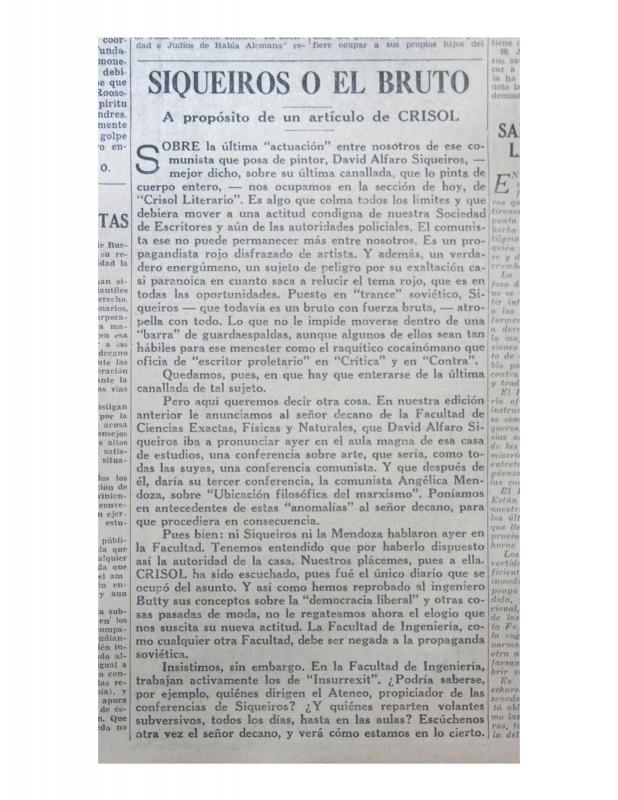Having been expelled from the United States, David Alfaro Siqueiros (1896–1974) traveled to Montevideo in February of 1933, and by the end of May in that same year, he had established himself in Buenos Aires. In the River Plate, Siqueiros experimented with technique and presented arguments based on the contents of his lecture Los vehículos de la pintura dialéctico-subversiva [The Vehicles of Dialectical-Subversive Painting], which he had developed while in the United States. In June he exhibited at Amigos del Arte [Friends of Art], a liberal and modernizing arts institution. He gave controversial lectures that polarized the arts field into the defenders of “arte puro” [“pure art”] and “arte político” [“political art”]. He was supported by Contra. La revista de los francotiradores [Against: The Snipers’ Magazine], run by leftist writer Raúl González Tuñón [see documents 733230, 733314, and 733270, among others]. Siqueiros collaborated on the newspaper Crítica [Critique], run by Natalio Botana. Botana commissioned Siqueiros to paint a mural in the cellar of his house, Quinta Los Granados, in Don Torcuato, in the Province of Buenos Aires.The Equipo Poligráfico Ejecutor [Lead Polygraphic Team]—formed by Siqueiros, Antonio Berni (1905–1981), Lino Enea Spilimbergo (1896–1964), Juan Carlos Castagnino (1908–1972), and the Uruguyan set-designer Enrique Lázaro—created Ejericio Plástico [Visual Exercise], with distorted nudes over the curved surface of the vaulted ceiling, by means of photographic projection. It was conceived as a fresco on cement, using such technical innovations as application by mechanical tools and the use of industrial silicates. In December 1933, sketches and photographs of the mural were exhibited in the magazine Signo [Sign] premises. Currently the work is in storage due to litigation; damage may affect its conservation. During the period, Argentinean right-wingers strongly attacked the Mexican Communist painter in its publications Bandera Argentina [Argentinean Flag] and Crisol [Melting pot], which were representative of the Catholic nationalism that had gained momentum since the 1930 military coup. Momento Plástico [Visual Moment] was the publication of the artists who came together to form the Corporación de Artistas Plásticos [Association of Visual Artists], a professional association split from the Argentine Society of Visual Artists guild. The five issues of Momento Plástico [Visual Moment] were published in tabloid format between April and August of 1933. The galley proofs of issue 6 have been preserved. The institution got some visibility in a brief time, confronting both the Comisión Nacional de Bellas Artes [National Commission of Fine Arts] as well as the plans to reform arts education. Emilio Pettoruti, Atilio Boveri, and Alfredo Bigatti were prominent among those who collaborated on Momento Plástico and were also distinguished members of the Association of Visual Artists. Mario [A.] Canale, student of Eduardo Sívori, served as editor of the magazines Athinæ (1908–11) and El Grabado [Engraving](1916). In addition to promoting union activities, beginning from the time he studied at the Academia de Bellas Artes [Fine Arts Academy], he was also on staff at the Comisión de Bellas Artes [Fine Arts Commission] of Buenos Aires. Canale was a lecturer at the Universidad de la Plata until the nationalist military interventions of the 1940s. Mario Canale challenged Siqueiros’s intervention in Argentinean art milieu mainly on two fronts: his lack of familiarity with the local environment, which was different from that of Mexico, and his ideological content, such as “sociological art.” In this sense, Canale’s criticism is part of those critiques made by the defenders of the formal modernity of art, the latter never attachd to political discourse. [See the remaining documents on Siqueiros in Argentina: 733206, 734050, and 734077, among others].






